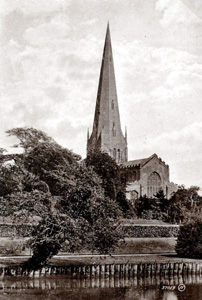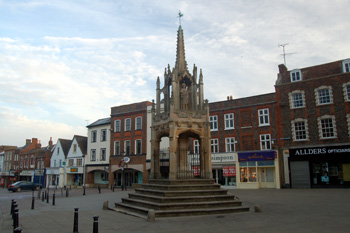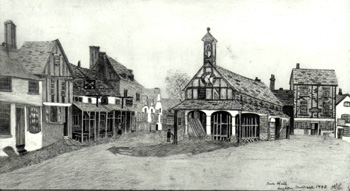
All Saints from the river about 1910 [Z1130/72]
Leighton Buzzard lies beside the River Ouzel, at a bridging point, on gently rising ground above the level of flooding. The original town would have consisted of the High Street, which was laid out ascending this low rise with the Market Square at the top, two main roads - North Street and Lake Street leading north-east and south-east respectively and the area around the bridge (originally called Lovel End) and the church, unusually at the bottom of the slope.

High Street, Market Square and Cross June 2008
The Domesday Book states that a market was held in Leighton and it may well have origins in the pre-Conquest Anglo-Saxon period. It is not known where it was held. No evidence exists to suggest that the market of 1086 was not in the present Market Square, but it may have been elsewhere, closer to the bridge over the River Ouzel and around the church, for example, and it is possible that the present site may have been a piece of early medieval town planning. This may help to explain why All Saints church is not at the top of the slope and in the prime location of the town, as would normally be expected - perhaps the prime location, the market, shifted in the 12th century but the church, naturally, remained in its established position.

Town Hall and Market Square in 1798 [Z50/72/38]
The typical layout of an early medieval market town consisted of burgage plots, that is to say strips of land running back directly from and at right angles to the High Street and/or Market Place. Despite such burgage plots, Leighton Buzzard never achieved borough status and thus never had burgesses (freemen of a borough who acted as officials). Perhaps it would be better to refer to shoprows rather than burgage plots as the term shoprow was used in a document of 1491: "…one void piece of land lying in the Shoprows in Leighton on the south part between the Highway on the north part and the Highway near the Motehall leading to the Hethe". This unusual description seems to refer to a piece of land on the "island site", called Middle Row, in the Market Square - the Motehall, or Moot Hall, being the later Town Hall, itself later a Fire Station. The nearby Market Cross is 15th century, though it may stand on the site of an earlier one.

The Market Cross about 1800 [Z1130/72]
Leighton Buzzard was clearly a reasonably thriving market town in the early Middle Ages but must, like everywhere else in Europe, have received a set back with the advent of the Black Death. This came to England in 1348, the first case being recorded in Melcombe Regis, now Weymouth in Dorset. It had reached Leighton Buzzard by the next year as evidenced by the deaths of two successive vicars of All Saints in that year.